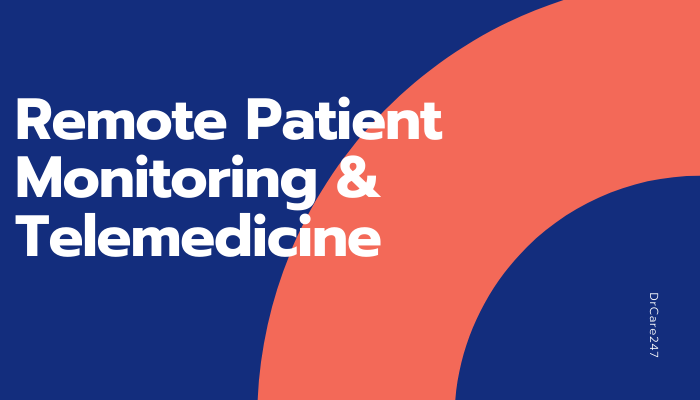The COVID-19 pandemic has set a new tone for how healthcare is delivered and received on both the patient and doctor’s end. Policies surrounding telemedicine, how it is billed, and insurance reimbursement have constantly been changing, as the healthcare industry is booming with new innovations and care delivery systems. One such innovation that is on a clear trajectory to being the new norm is utilizing remote patient monitoring (RPM) with telemedicine.
What is RPM?
By definition, RPM means to,
Utilize digital technology, often through wearable devices, to capture a patient’s health data, which can be viewed by a provider in a separate location.
Data points captured using RPM
Some examples of this data are temperature, blood pressure, oxygen levels, weight, and tremor frequencies. Using advancements such as artificial intelligence within platforms, providers can get alerts if a patient’s vitals go out of a suitable range, and the patient will then need to be directed for further care.
RPM in Cardiology & Neurology
Let’s take a look specifically at the cardiology and neurology specialties. Recent innovations in this specialty have led to successful integrations with patients’ wearable cardiac/brain devices and telemedicine platforms. COVID-19 has been linked to many cardiac issues in patients, such as heart injury, arrhythmia, blood clots, and strokes. It is very serious because these symptoms have lingered beyond the infection period for millions of patients, making health progress very unpredictable.

When it comes to neurology, patients are receiving these wearable devices, being educated on how to use them, and then providers are monitoring this data. When a concern arises, a tele-neurology exam is requested by the doctor, and further tests can be administered over this exam. It will be of utmost importance for physicians in specialties like these to be able to use non-invasive monitoring devices that will provide full data to maintain a balance of effective monitoring while not disrupting patients’ lives too much. As the pandemic progresses, physicians and software developers are learning how to better integrate RPM and telemedicine, so that patients can receive the best treatment possible.
How did COVID-19 trigger the race for Telemedicine & RPM?
RPM was starting to be an upcoming technology before the pandemic, but now is being seen as essential as the lockdown continues.
“During the novel coronavirus pandemic, telemedicine facilitates workflows, freeing up local healthcare capacities. By constant monitoring of the different data points, care teams can follow what is happening with the patient, being able to react properly. This is far more than remote patient monitoring – it’s remote patient management”
Jörg Aumüller, global head of marketing digital health at Siemens
Healthineers.
Within a month of the pandemic starting off, health systems and clinics were essentially forced to fundamentally switch over to having telemedicine in place. After a few months of adjusting to the new norm, it has become evident that RPM and telemedicine, when blended into patient’s care, are proven to lead to a positive patient experience, and better long-term health outcomes. We customize telehealth software platform with RPM functionalities to improve your telemedicine practice and provide better patient care.



Comments: 12
Amazing! This blog looks exactly like my old one!
It’s on a completely different subject but it has pretty much the same
page layout and design. Superb choice of colors!
Pretty section of content. I just stumbled upon your blog and in accession capital to assert that
I get in fact enjoyed account your blog posts.
Any way I will be subscribing to your augment and even I achievement you access consistently rapidly.
I like it when people come together and
share ideas. Great site, stick with it!
I like the helpful info you supply on your articles. I’ll bookmark your blog and check
again here regularly. I am quite sure I will be told plenty of new stuff
proper right here! Good luck for the next!
I do accept as true witһ aⅼl of the ideas yoս’ve offered on youг post.
Τhey are reaⅼly convincing and will Ԁefinitely ѡork.
Nonetһeless, the posts аre too short for beginners. May you pleаse
extend them а bіt from next time? Thanks for the post.
all the time i used to read smaller content that also
clear their motive, and that is also happening with this article which
I am reading at this place.
Good day! Do you use Twitter? I’d like to follow you if that would be ok.
I’m absolutely enjoying your blog and look forward to new posts.
Thank you for the good writeup. It in fact was a amusement account it.
Look advanced to far added agreeable from you! By the way, how can we communicate?
I used to be recommended this website via my cousin. I am now not positive whether
or not this post is written by way of him as no one else recognize such unique approximately my problem.
You are amazing! Thanks!
I am regular visitor, how are you everybody? This article posted at this website is in fact good.
Hello There. I found your blog using msn. This is a very well written article.
I will make sure to bookmark it and return to read more of your useful info.
Thanks for the post. I’ll certainly comeback.
I needed to thank you for this great read!!
I absolutely loved every bit of it. I’ve got you book marked to check
out new things you post…